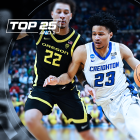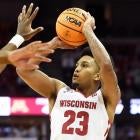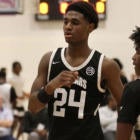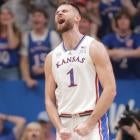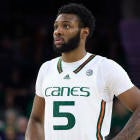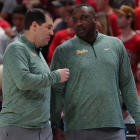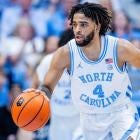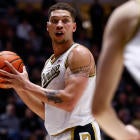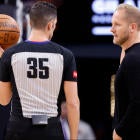It was a good decision. It was a terrible decision. I would've advised him differently. The new rule really helped this guy. He should've gotten a better sense as to where teams were on him before he finalized his decision. These are just some of the statements that NBA Draft analysts will utter as the draft season comes to a close, and players find themselves being drafted or undrafted.
Notable players who went undrafted this year include Naz Reid (LSU), Shamorie Ponds (St. John's), Louis King (Oregon), Dedric Lawson (Kansas), and Jontay Porter (Missouri). While the immediate impact of being undrafted is difficult to absorb, players don't have to look far to see that success in the league is possible. Udonis Haslem, Wesley Matthews, Ben Wallace, Bruce Bowen, and Avery Johnson, are just a few of the many undrafted players who made it to the NBA.
Let's face it. Even though a majority of people in this world will likely never be in the position to be drafted by an NBA team, we can empathize with the feeling of rejection and repudiation. The thing to not lose hold of is that when one door closes, another may open. For some, that opportunity comes quickly. Take Reid for example. He was signed as an undrafted free agent, played extremely well in the Summer League, and worked his way into a guaranteed contract with the Timberwolves. Now, he has a chance to turn his story on its head, and write its next chapter.
With many players deciding to enter the draft, there were also many who decided to return to college. Reasons for a players return certainly vary, as they gather more and more information as the combine occurs, and individual workouts progress throughout April and May. As mentioned earlier, second-round picks aren't guaranteed contracts, so a player may decide to return to school if that is where they're projected to be selected. Players also may be told, or simply know that there are certain areas of their game in which they need to improve upon, and feel like another season in college will help them do that.
Regardless of the reason, many prospects decided to pull their names out of the draft and return to school. There are many whose career has reaped the rewards of a return to school. Players like Chandler Parsons, Damian Lillard, and Kenneth Faried come to mind, as players who chose to return to school -- in their cases for all four seasons -- and have gone on to have solid to stellar professional careers.
This season, I believe there are many players who stand to benefit from their decision to return, as the new rule has certainly helped players a bit more in their decision making, but let's take a deeper dive into the four players that could benefit the most from making the return to college. There are certainly more than four that will benefit, as players like Jordan Nwora (Louisville), Markus Howard (Marquette), Jalen Smith (Maryland), Kerry Blackshear Jr. (Florida), Devon Dotson (Kansas), and Sam Merrill (Utah State) aren't' on this list, but here are the four who are poised to see major benefits upon their return.
Ayo Dosunmu, Illinois
Dosunmu took the Big Ten by storm in his freshman season, as he averaged 13.8 points per game en route to being named to the conference's all-freshman team. Dosunmu, who many draft experts had projected to go in the second round, decided to return to Illinois, and will have a tremendous opportunity to improve his stock.
Dosunmu, while electric at times, was also inconsistent, as the Illini seemingly went as he went. He recorded a season-high 25 points in a loss to Georgetown, while filling up the stat sheet in big wins over Michigan State (24 points) and Maryland (20 points). In that win over the Spartans, he was 8 for 14 from the field and 4 for 8 from behind the arc. His inconsistencies showed throughout the usually difficult and challenging Big Ten schedule, as he shot just 1 for 9 in a loss to Ohio State, and 4 for 16 in a home loss to Wisconsin. Dosunmu shot 53% from the field in Illinois wins and 46% in Illini losses. His value can't be understated and should mean even more to Illinois this season.
Even the numbers in losses probably wouldn't set off any alarms, but we are now talking about a potential first round pick--possibly even a lottery pick. He's projected as a first round pick in 2020, and CBS Sports' Kyle Boone, has him projected to go as high as 10th overall. The skill, talent, ability, and work ethic are all there for Dosunmu, as there's seemingly few that doubt that. A big sophomore season could reap large rewards.
Strengths: Dosunmu can really score the ball and he can make shots. As previously mentioned, he will need to become more consistent and score more consistently in a variety of ways, but this guy can get buckets. Beyond just the halfcourt game, Dosunmu is electric in transition, and has high-level vision at the guard spot. In fact, 32% of his total points were scored in transition, according to Synergy. He led the Illini in scoring, and was also second in steals and third in rebounds. Dosunmu is a terrific all-around talent, that has the ability to go for 25-30 points every time he steps on the floor. He plays with passion and excitement, and his energy is contagious. He's also a proven winner. Dosunmu won two state championships while at Morgan Park High School in Chicago, and played a major role on the USA U18 team that won gold at the FIBA Americas in 2018.
Weaknesses: Despite the possibility of being an elite scorer, his inconsistencies need to be improved upon. While leading his team in scoring, his shooting percentages won't overwhelm you. He shot 43% from the field, 35.2% from behind the arc and 69.5% from the free-throw line. Dosunmu is a very shifty guard, who is quick, and has very good handle at the guard position. At times, he gets to the rim at will, but he needs to finish better when he gets there, and when he gets to the free-throw line, his percentage must improve. The 3-point shooting was good for his first season, so I'm far less concerned about that, but along with improved physical strength, those shooting percentages must go up. He also needs to improve with the ball in his hands in the pick-and-roll. According to Synergy, he made just 31% of his field-goal attempts off of the pick-and-roll, and in the NBA there are plenty of pick-and-roll schemes.
What he has to gain from returning: I don't like to answer this question this way, but the possible financial gain for Dosunmu could be immense. Again, first-round contracts are guaranteed, and while he's projected all over the first round right now, a really solid sophomore season could cement his place in the first round. I really love his game and his competitiveness. The major areas he needs to improve are in his hands. In regards to strength and conditioning, this is the first offseason where he will be fully healthy, after spending the previous two offseasons rehabbing injuries.
In regards to improving his shooting consistency, I believe this goes hand-in-hand with being healthy. More time in the gym shooting equals more reps. I had a coach tell me one time, "great shot makers will make shots." That's a very simple statement. Dosunmu might not be a great shot maker...yet. He certainly has the tools and the skillset to become just that. He is an elite player in the Big Ten, who will be going against tough defenses day in and day out. Dosunmu is primed to have a breakout season in 2019-20, and if the Illini can follow suit as a team, and make the postseason, it will likely be in thanks to Dosunmu's performance, and that will do a lot for him.
Killian Tillie, Gonzaga
There are few players who may have more to gain from a return to school than Tillie. After missing most of the 2018-19 season due to both ankle and foot injuries, Tillie returned to a loaded Gonzaga team and never truly found his rhythm, as Brandon Clarke and Rui Hachimura led the way offensively for the Bulldogs. Tillie finished last season averaging just 6.2 points and 3.9 rebounds in 16.6 minutes per game.
The thing that will benefit Tillie is that there is certainly a "position" that has become highly sought after at all levels and that is the stretch-4. A player with size that has the ability to post up, as well as step behind the arc and knock down threes. A player that, because of his ability to score from three levels, can become an extremely difficult person to defend. Tillie, at 6-10, could be the ideal stretch-4, and should have the opportunity to prove that this season, as a healthy go-to option in Mark Few's offense.
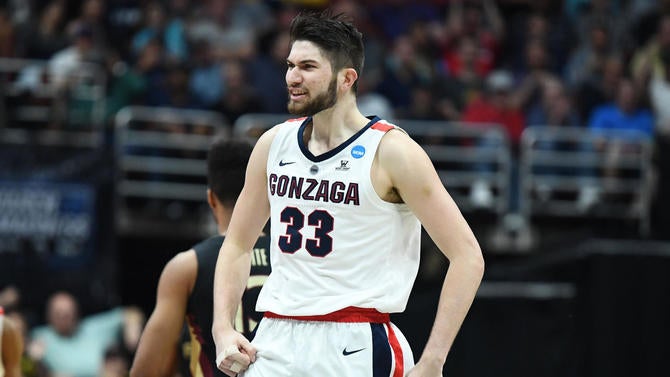
Tillie did average 12.9 points and 5.9 rebounds per game as a sophomore and in three collegiate seasons, he's shooting an other-worldly 47% from 3-point range. Tillie put his name in for the draft this year, but ended up pulling out of the combine due to an ankle injury. Coming off of multiple injuries now, the one thing that he may need to prove, is that he can simply stay on the floor.
Strengths: Tillie's biggest strength is his ability to shoot the 3-point shot at a high level, especially at 6-10. He is also a good screener, who can provide multiple options after the screen, such as rolling to the rim, running, slipping, or popping, which is his best and most lethal post screen option. His ability to play and move without the ball is also an important skill for Tillie, as is his catch-and-shoot ability. Depending on the offensive system Tillie were to find himself in at the next level, his ability to pick and pop or be a set shooter, will both be extremely valuable. He shot 42.3% from the field in spot-up situations and 46% in catch-and-shoot situations last season according to Synergy, and that was in an abbreviated and interrupted season. Beyond his ability to shoot it at a high level, Tillie is a really good passer for a big man. He doesn't have the size of a Pau Gasol, but like Gasol, he has great vision, and sees the floor extremely well.
Weaknesses: In short, he needs to get quicker and stronger. While Tillie is a decent rebounder at his position in college, in the NBA he is going to be going up against players who are much bigger and stronger, and could eliminate his rebounding ability, while also being able to step out and defend him at the 3-point line. His ability to shoot the basketball will likely find him an NBA spot, but his ability to defend and battle on both ends of the floor, and rebound on the defensive end, is what might keep him there...or not.
What he has to gain from returning: The recipe is fairly clear for Tillie: get stronger, faster, show an improved ability to defend multiple positions, and show an improved ability to rebound and compete in the paint, all while continuing his near 50% shooting prowess from behind the arc. Sounds easy, right? Reaching his potential in all of these areas may prove to be a tall task, but the biggest hurdle for Tillie is going to be his health. At 6-10, already having gone through a foot injury that sidelined him for most of last season, Tillie needs to prove he can stay on the court for Gonzaga this season. That is the most important part of his 2019-20 season.
If Tillie does stay healthy, there is a place for a player with his skillset at the next level. I think that if he continues to shoot the ball at a high level, while showing growth in the areas of strength and quickness, he's a first-round lock in 2020. Look no further than a player like Cameron Johnson. Johnson has similar size to Tillie at 6-9, and shot 45% from behind the arc for North Carolina last season. Johnson, who was projected to be selected in the 20s, was picked 11th by the Minnesota Timberwolves.
If Tillie makes a big leap in these areas, while diversifying his game a bit toward showing that he can do more in the post and around the rim, while improving his defense, and leads Gonzaga to a deep tournament run, there is lottery potential there.
Myles Powell, Seton Hall
There was jubilation in South Orange, New Jersey on May 29, 2019, as Powell made the announcement that he would be returning to Seton Hall for his senior season. The Trenton native's return instantly catapulted the Pirates to near the top of many experts preseason Big East projections. Some even hoisted the Pirates into the top-15 nationally.
While Seton Hall's team success will have some impact on Powell's future, the consensus is that the return to school will only benefit him moving forward. The All Big East first-team selection averaged 23.1 points, 4.0 rebounds, and 2.9 assists per game last season. He proved himself to be an extremely durable player as well, averaging 36 minutes per game, as he started all 34 games for the Pirates.
Strengths: As we saw with Carsen Edwards in this year's NBA Summer League, some people can just flat out score the basketball: Powell is that type of player and is similar in size to Edwards (6-1). He's a scorer. He had eight games with 30 or more points this season, and we all saw him go toe-to-toe with Markus Howard--the Big East's leading scorer-- twice in the last two weeks of the season, including an overtime win in the Big East semifinals. He finished third in the Big East in three-pointers made, and was first in made field goals. Powell finished second in the league in both points scored and points per game (behind Howard). Powell is strong, tough, and physical, and at just 6-2, which is on the smaller side for a guard, especially at the next level, his ability as a shooter becomes that much more important.
Weaknesses: In a sport that continues to challenge the notion of traditional positions, as there is more and more of a push to positionless basketball, with Powell, the guard fit is a question at the next level. Not that he can't be a guard in the NBA, but what type of guard can he be? He's smaller than the average shooting guard, and he also isn't a pure point guard. Powell's handle, while good, isn't one that NBA scouts would currently marvel at. To be a point guard, he would need to become a better passer and distributor of the basketball; he just hasn't shown that part of his game to be next-level ready just yet, and his size could limit him at the two.
What he has to gain from returning: It will be interesting to see how Edwards fairs in the NBA, because I think there are a lot of comparisons in regards to the ability to score the ball. That said, Powell's physicality and toughness as a guard could compensate for what he might lack in height. If Powell can show that he can be a better distributor and improve his handle enough to prove that he can run the point at the next level, that should certainly improve his draft stock. He doesn't have to be a point guard, but he has to have the ability to run the point. Having the skill set to play multiple guard spots will only help him.
I'm not too concerned about his turnover rate; certainly not as concerned as some others appear to be. He did have the third most turnovers in the Big East, but he was also 2nd in total usage. From the 2017-18 season to last season, his turnover percentage, which calculates the number of turnovers per 100 possessions, increased by just .1 from 13.1 to 13.2. This was a minor increase considering his usage percentage increased from 23.1% to 30.9%; therefore, Powell actually showed improvement in this part of his game.
Many draft experts had Powell as undrafted if he stayed in this year. His return will likely pay dividends for both him and the Pirates. Let's face it, the NBA team that drafts or signs Powell will do so because of his scoring. EVERY NBA team needs a bucket getter: Powell is that. If he can tighten up his weaknesses, and lead Seton Hall to the NCAA Tournament, he should end up in a much better position come next spring. We have seen what a great tournament run can do for players as well. If the Pirates make a run, it will be because Powell leads them there, and that is something I can certainly see.
Lamar Stevens, Penn State
If this is the first you're hearing this name, you should spend some time getting to know him. While football remains king to a majority of the school and its constituencies, Penn State has a basketball star in Stevens. They were unable to capitalize last season on their 26-13 record and NIT championship from 2017-18, en route to a 14-18 record last season, and it's likely that the failure of the Nittany Lions to make an NCAA Tournament in the three seasons Stevens has been on the team, has certainly hurt his notoriety.
Despite Penn State's struggles in the Big Ten, Stevens has been an impressive talent for three seasons now. He is already fifth on the school's all-time scoring list and has surpassed both the 1,500 point and 600 rebound marks. Stevens started all 33 games as a freshman, averaging 12.7 points and 5.5 rebounds per game. As a sophomore, he increased those numbers to 15.5 points and 5.9 rebounds per game, as he helped lead Penn State to an NIT championship, where he was named NIT Most Outstanding Player, following a 28-point performance in the team's win over Utah. Last season, Stevens was an all Big Ten first team (coaches) and second team (media) selection, as his numbers continued to rise. He posted 19.9 points and 7.7 rebounds per game. Most importantly, he started and played in all 32 games, averaging 36.9 minutes. Perhaps his most impressive statistic while at Penn State, is the fact that he has never missed a game. He has started and played in all 104 games since his freshman season.
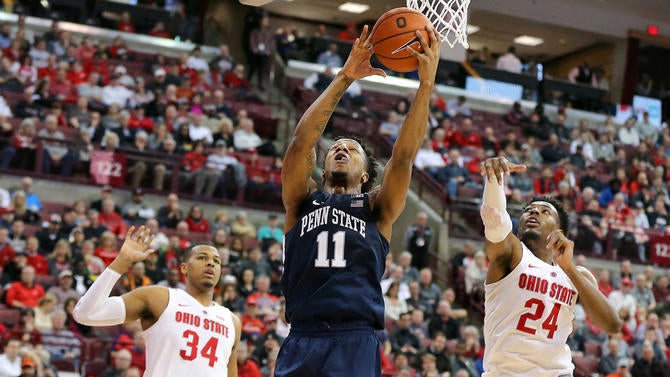
At 6-8, 230 pounds, Stevens has the build to compete at the NBA level. He can score the ball as he has displayed throughout his time in the Big Ten, and is also a very good free-throw shooter. He is a terrific rebounder, can handle the ball well, and is an above average defender. One thing that is noticeable about Stevens on the defensive end is his explosiveness. He can guard multiple positions, rebounds extremely well, and blocks shots. Most importantly, Stevens competes extremely hard on both ends.
Strengths: Stevens' size and physical strength are undoubtedly a positive for him. His ability to be a very good rebounder--possibly an elite rebounder--will also serve him well. Stevens defends well, and offensively, he can score both at the rim and from the mid-range. He is also extremely durable having not missed a game in three seasons as a starter. Stevens is simply a solid all-around player, that is oftentimes one of the fiercest competitors on the floor, with limited weaknesses. While he struggles from beyond the arc, he excels in transition.He will need to show that he can improve in multiple areas this season, but I can see him playing a similar role to a player like P.J. Tucker, which is extremely high praise.
Weaknesses: Stevens needs to shoot a better overall percentage. He did finish 13th in the Big Ten in field-goal percentage at 42.2%, but that needs to improve, specifically his 3-point percentage needs to improve immensely. He shot just 22% from 3-point range last season, and only 28% over his three seasons. In fact, even though his shooting volume has increased from behind the arc just slightly, his percentage has dropped significantly. In particular, Stevens will need to improve his spot up and catch-and-shoot abilities. According to Synergy, Stevens was just 37 for 112 (33%) in spot-up situations and 23 for 92 (25%) in catch-and-shoot opportunities. This is going to be key for Stevens. If he can knock down the 3-point shot at a percentage somewhere in the mid-30s, his stock will undoubtedly rise.
What he has to gain from returning: The answer is simple: a lot. He will be returning for his senior season and graduate with a degree from Penn State--that's where it starts.
While he may have an NBA-ready body, his game isn't there yet. The inability to consistently hit the 3-point shot is a problem. He's likely to play the small forward position at the next level, as while he's played a lot of the power forwards spot at Penn State, that is just unlikely at the NBA level, unless he finds himself in a system with a smaller lineup like Draymond Green in Golden State. For many players who remove their names from the draft and return to college, a simple answer for something to improve on is that they need to get stronger (see Tillie). For Stevens, that's a fine goal, but what is clear, is that he needs to find ways to not completely reinvent his offensive game, but to robustly add to it.
Stevens, while needing to improve his 3-point shooting, also needs to improve on scoring out of the pick-and-roll, the catch-and-shoot, and play better off the ball. He is strong enough and good enough to take even the best defenders in college basketball one-on-one and hit the mid-range jumper when needed. While the mid-range skill is a good one to have, if Stevens can develop these other aspects of his game, specifically on the offensive end, he could end up having a nice professional career.












